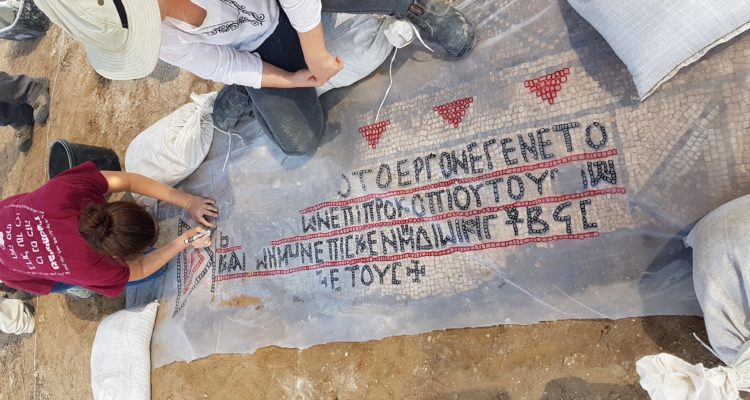Israeli and German archaeologists have uncovered a 1,500-year-old colored mosaic floor of Georgian church with an inscription in Greek mentioning the year of its construction according to the Georgian calendar.
By: Mara Vigevani/TPS
Israeli and German Archaeologists have uncovered a 1,500-year-old colored mosaic floor of Georgian church with an inscription in Greek mentioning the year of its construction according to the Georgian Calendar, The Israel Antiquities Authority said Thursday.
The inscription is a four-line commemoration in Greek dedicated to the structure’s builders. The inscription mentions Bishop Procopius, in whose day the church was built, and the year of its construction, apparently according to the Georgian calendar:
“[By the grace of God], this work was done from the foundation under Procopius, our most saintly and most holy bishop, in the month Dios of the 3rd indiction, year 292.” the inscription reads.
According to Dr. Leah Di Segni of the Hebrew University of Jerusalem, who deciphered the inscription, the date according to the Georgian calendar corresponds to the year 539 CE. “This is the earliest appearance of the use of the Georgian calendar in the Land of Israel, many years before it was used in Georgia itself,” Dr. Di Segni said.
Di Segni told Tazpit Press Service (TPS) that is it was particularly difficult to figure out what year in the Gregorian calendar the inscription referred as local dating systems were used at the time, for example from Gaza, Ashkelon or Bet Govrin.
“In that period every city had their own system to calculate the date,” Di segni told TPS “When I was asked by Dr Fantalkin to solve the case, I thought out of the box and tried to understand if the date of the inscription could fit other systems, even if far away from the region. I knew about inscriptions that used the Gregorian calendar in Jerusalem and understood it could fit in this case as well.”
The colored mosaic came to light during an excavation at the Ashdod-Yam antiquities site, in a joint project between Tel Aviv University, Leipzig University and the University of Göttingen.
The ancient city of Ashdod-Yam, on the coast of what is now the southern part of the city of Ashdod, was one of the most important cities on the coast of the Land of Israel in the Byzantine period and was known as Azotus Paralios.
Dr. Alexander Fantalkin, Dr. Balbina Bäbler of the University of Göttingen,
and Sa‘ar Ganor, Israel Antiquities Authority Ashkelon district archaeologist.
said: “As far as we know, Ashdod is now home to the largest community of Jews of Georgian origin in the world. Testimony to the presence of the actual Georgians in the Land of Israel as far back as the Byzantine period has been found dozens of kilometers from Ashdod – in Jerusalem and its surroundings. But this is the first time that a Georgian church or monastery has been discovered on the Israeli coast.”
The archaeologists said that according to historical sources, the famous Georgian prince and bishop Peter the Iberian lived in Ashdod-Yam before his death. “And now it seems that we have uncovered actual evidence of his influence on the Byzantine city of Ashdod-Yam,” they added. “This public structure, which has only now begun to come to light, is part of an extensive archaeological complex in the southern part of modern Ashdod.”




